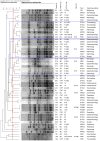Molecular Epidemiology of Staphylococcus epidermidis Implicated in Catheter-Related Bloodstream Infections at an Academic Hospital in Pretoria, South Africa
- PMID: 29563910
- PMCID: PMC5845871
- DOI: 10.3389/fmicb.2018.00417
Molecular Epidemiology of Staphylococcus epidermidis Implicated in Catheter-Related Bloodstream Infections at an Academic Hospital in Pretoria, South Africa
Abstract
Staphylococcus epidermidis is one of the most prevalent pathogens implicated in catheter-related bloodstream infections (CRBSI) at an academic hospital in Pretoria, South Africa. Little is known about the clonality and the prevalence of antibiotic resistance and virulence genes in S. epidermidis (e.g., icaAB, IS256, mecA, and qacA/B). A total of 508 intravascular catheters (IVCs) from 331 patients were submitted for culture from May to October 2013. Only 50% (n = 253/508) of the IVCs were accompanied by blood cultures (BCs) taken within 48 h. Forty-four percent (44%; n = 112/253) of IVCs were colonised, of which 26% (n = 65/253) were associated with a CRBSI. We identified S. epidermidis as the causal agent in 31% (n = 20/65) of the CRBSI cases. Fifty-nine S. epidermidis isolates were obtained, 23 isolates were cultured from 22 IVCs and 36 isolates were cultured from 36 BCs. All S. epidermidis isolates were resistant to β-lactams (100%; n = 59/59), followed by high levels of resistance toward erythromycin (86%; n = 51/59) and gentamicin (81%; n = 49/59). The mecA gene was prevalent in all the (100%, n = 59/59) isolates. Isolates contained the IS256 element (83%, n = 49/59), the icaAB gene (81%, n = 48/59) and, the qacA/B gene (81%, n = 48/59). All 48 isolates were qacA positive upon restriction enzyme digestion of the qacA/B amplicons. Phenotypic resistance toward 0.5% (m/v) chlorhexidine was not observed. Staphylococcal Cassette Chromosome (SCC) mec typing showed that SCCmec type IV (31%; n = 18/59) was the most prevalent. The remaining SCCmec elements were highly diverse. Pulsed-field gel electrophoresis (PFGE) showed that S. epidermidis isolates from individual patients were mostly clonal. Multilocus sequencing typing (MLST) of 10 sequenced isolates showed that sequence type (ST) 2 (40%; n = 4/10) was the most frequently detected, followed by ST54 (20%; n = 2/10), ST28 (10%; n = 1/10), ST59 (10%; n = 1/10) and ST490 (10%; 1/10). One isolate was newly assigned to ST596. These S. epidermidis infections can be attributed to patients' skin microflora or to poor infection control practices. Currently, S. epidermidis strains circulating in the studied hospital are multidrug-resistant and highly adaptive to environmental changes.
Keywords: MLST; PFGE; SCCmec typing; ST2; ST596; South Africa; Staphylococcus epidermidis; catheter-related bloodstream infections.
Figures



References
-
- Clinical Laboratory Standards Institute (CLSI) (2013). Performance Standards for Antimicrobial Susceptibility Testing: Twenty-third Informational Supplement M100-S23. Wayne, PA: CLSI.
LinkOut - more resources
Full Text Sources
Other Literature Sources
Research Materials

